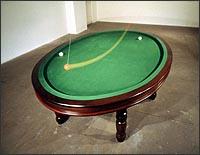Common Wealth
dal 21/10/2003 al 28/12/2003
Segnalato da
21/10/2003
Common Wealth
Tate Modern, London
A group exhibition that brings together five celebrated international contemporary artists from Europe and Latin America, in the most important display of their work in the UK to date. Featuring Jennifer Allora and Guillermo Calzadilla, Thomas Hirschhorn, Carsten Holler, and Gabriel Orozco, the exhibition presents around 15 large-scale installations, many of which are interactive and encourage visitor participation, as a way of exploring the meanings, implications and politics of the words 'common' and 'wealth'.

Common Wealth is a group exhibition that brings together five celebrated international contemporary artists from Europe and Latin America, in the most important display of their work in the UK to date. Featuring Jennifer Allora and Guillermo Calzadilla, Thomas Hirschhorn, Carsten Höller, and Gabriel Orozco, the exhibition presents around 15 large-scale installations, many of which are interactive and encourage visitor participation, as a way of exploring the meanings, implications and politics of the words 'common' and 'wealth'.
Collaborative artists Jennifer Allora (b. 1974 Philadelphia, US) and Guillermo Calzadilla (b. 1971 Havana, Cuba) are based in Cambridge, Massachusetts and Puerto Rico. Their work examines the 'space of encounter between peoplex{2026}whether it's psychological territory or a physical terrain.' Their newly commissioned work Landmark 2003, on display in Common Wealth, uses a cartographic felt floor to recreate the cratered landscape of Vieques, an island off Puerto Rico used by the US military for bombing practice. Their ongoing project Chalk encourages the public to express themselves through chalk marks on city streets, and has taken place in New York and Lima, Peru. Their work is currently on display in the group show, How Latitudes Become Forms: Art in a Global Age at The Walker Art Center, Minneapolis, until 4 May. Landmark
Courtesy Arndt & Partner, Berlin Swiss-born artist Thomas Hirschhorn (b. 1957) works in Paris. He creates makeshift environments using everyday materials such as plastic sheeting, cardboard, aluminium, and torn magazine pages, which reflect upon current social issues. Recent installations include World Airport 1999, at the Venice Biennale in 1999 and Bataille Mounument 2002, at Documenta 11 2002. A new work, Hotel Democracy, is being made for this exhibition. Visitors will be able to walk around the model building of two floors, looking into the various rooms at images taken from the media that relate to struggles for democracy. The Utopian Lounge presents political and philosophical texts as well a selection of Vorticist works from the Tate Collection.
Carsten Höller (b. 1961 Brussels) lives in Stockholm. His works create communal experiments in which the visitor determines the rules. Included in this exhibition is Frisbee House 2000, a tent-like structure that can be entered, and is filled with 30 frisbees that visitors can throw to each other or, through holes in the fabric, to unseen participants in the gallery. His solo show is currently on view at the ICA, Boston and his work was recently shown at the Fondazione Prada, Milan.
Gabriel Orozco (b. 1962 Mexico) works in Mexico City, Paris and New York. Through his works the artist invites visitors to make their own games. Included in Common Wealth are Ping Pond Table 1998, which consists of four ping-pong tables surrounding a lily pond, and Oval with Pendulum 1996, a round billiard table with two white balls and a third red ball attached to a pendulum. Recent solo shows of his work include a retrospective at MoCA, Los Angeles (2000) and the Stedelijk Museum, Amsterdam, (2000). He was included in the 1997 Whitney Biennial.
The exhibition, curated by Tate Modern Curator, Jessica Morgan, will explore the meanings and implications of the words common and wealth including ideas about the potential use-value of art, how it might contribute to a shared public prosperity, and what common ground is offered by architecture and museum galleries. To use a statement by Hirschhorn, the artists in Common Wealth are interested in making art politically rather than making political art. Their work seeks to bridge the individual and the communal, by developing local practices that remain critically aware of the global situation.
Image: Gabriel Orozco, Oval Billiard Table 1996
Courtesy Marian Goodman Gallery
© The artist
Tate Modern
Bankside
London



